Still life is a popular and much admired genre, it can be found in many homes around the world in a wide variety of styles. From antiquity to contemporary art, still life has never ceased to be the jumping off point for in depth artistic endeavours – however, there are many who admire it for the simplicity alone, or for the ever-growing interpretations of life, abundance and mortality to be found in the floral and fruitful panels and canvases of the 16th century onwards.
 Above: examples of still life painting by Henri Fantin-Latour, Anne Vallayer-Coster, and Eugène Delacroix
Above: examples of still life painting by Henri Fantin-Latour, Anne Vallayer-Coster, and Eugène Delacroix
With many delicate details in antique still life required for their overall impact, and the bright and bold colours found in modern pieces, this genre requires a clean and clear canvas for optimum enjoyment and art historical understanding. Our studio has dealt with many still life painting restorations over the years, from those which have been discoloured due to fireplace or nicotine contamination through to tears and stains to the canvas surface. The results have allowed these intriguing artworks to be returned to their original appearance, as intended by the artist.
 Above: a still life painting of flowers, before and after restoration in our studio – a bright purple background was revealed
Above: a still life painting of flowers, before and after restoration in our studio – a bright purple background was revealed
To understand why it is important for a still life painting to show all of its details and original composition with clarity, it is helpful to know how to interpret them and look for symbolism. This article will cover the many ways in which still life paintings can be appreciated, as well as the history of the genre.
The history of still life paintings
In terms of art history, still life has not always been seen as the pinnacle of artistic talent, as the literal translation of objects onto canvas was not seen as a creative or imaginative pursuit and more of a training exercise for young artists. However, across time and with the input of many talented compositions, still life has become a fascinating genre in its own right.
 Above: two wall paintings from Pompeii displaying still life with trompe-l’œil techniques and a 2nd century mosaic
Above: two wall paintings from Pompeii displaying still life with trompe-l’œil techniques and a 2nd century mosaic
The earliest depictions of still life can be dated back to ancient Greece and Rome. Mosaics and wall paintings can be found at Pompeii and Herculaneum depicting an abundance of food produce, adorning wealthy villas where this would have been symbolic of good living and generous hospitality. The ancient Greek myth of Zeuxis and Parrhasius also tells us about the skill of still life artists, describing the first use of the trompe-l’œil effect. These are artworks which use light and shadow to make the items appear three dimensional, or as told in this legend – an artwork which is confused for real life.
 Above: examples of illuminated manuscript still life as seen in the Book of Hours from the 1470s
Above: examples of illuminated manuscript still life as seen in the Book of Hours from the 1470s
Throughout the middle ages, as is the case with many forms of western art, still life became dominated by Christian ideologies and symbolism. This can be seen in the floral and complex designs in illuminated manuscripts which went on to inspire the artists of the Northern Renaissance. Rather than subduing the quality of still life, Christian influence enhanced it further with a growing use of iconography intertwined with precise paintings of everyday items.
 Above: Fruit and Flowers by Orsola Maddalena Caccia (1630), Still Life with a Glass and Oysters by Jan Davidsz de Heem (1640) and Vanitas Still Life by Edwaert Collier (1662)
Above: Fruit and Flowers by Orsola Maddalena Caccia (1630), Still Life with a Glass and Oysters by Jan Davidsz de Heem (1640) and Vanitas Still Life by Edwaert Collier (1662)
Interests in natural history and exploration opened up from the 16th century and dominated the 17th century, allowing for further depictions of new and unusual fruits and objects from around the world. These still life artworks can have various meanings, from adventurous cabinets of curiosity, through to cornucopias and market stall scenes displaying extreme abundance. Influential artists throughout these periods practicing complex still life include Giotto, Petrus Christus, Jan van Eyck, Albrecht Dürer, Annibale Carracci, Hans Memling and Jacopo de Barbari.
 Above: a selection of vanitas paintings including Allegory of Charles I of England and Henrietta of France by Carstian Luyckx (1670), Trompe l’oeil with Studio Wall by Cornelis Norbertus Gijsbrechts (1668) and Vanitas with Skull by Cornelis Van Der Meulen (1688)
Above: a selection of vanitas paintings including Allegory of Charles I of England and Henrietta of France by Carstian Luyckx (1670), Trompe l’oeil with Studio Wall by Cornelis Norbertus Gijsbrechts (1668) and Vanitas with Skull by Cornelis Van Der Meulen (1688)
In the 17th century, especially in Dutch art, ‘vanitas’ was a common theme. Vanitas artworks were designed to compel the viewer into contemplating the impermanence of life itself – often they display material riches alongside icons of death and decay such as rotten fruit or a skull. There was also a revival of the trompe-l’œil effect, producing amazingly life-like paintings. Notable examples can be found in the works of Cornelis Norbertus Gysbrechts. Further names to look out for in this era include Ambrosius Bosschaert, Pieter Boel, Jan Davidsz de Heem, Pieter Claesz and even great works by Rembrandt.
 Above: a detail from Still Life with Silver by Alexandre François Desportes, 1720
Above: a detail from Still Life with Silver by Alexandre François Desportes, 1720
During the 18th century the baroque and rococo extravagance saw still life paintings combine perfectly with the decadent displays of wealth and preoccupation with idealised pastoral settings. In this era, still life was commissioned by nobility to exemplify their riches, such as the grand food they had access to, the produce of a hunt, or beautiful and expensive bouquets. This was all accepted without a moral lesson to be learnt from the painting, as the idea of vanitas was quite at odds with their lifestyle – although this did not stop artists from including hidden layers of deeper themes where possible. Grand floral paintings by Rachel Ruysch can be dated to this era.
 Above: a detail from a painting by Jan van Huysum showing the lifelike ants crawling across a vase of flowers
Above: a detail from a painting by Jan van Huysum showing the lifelike ants crawling across a vase of flowers
Academic art took hold at the end of the 18th century and dominated the next. During the 19th century still life was stuck at the bottom of the hierarchy due to strict ideas of what made great art. This is why those who pulled away from academic practices may have focused further on such genres, as a rebellion against the norm – giving still life yet another layer of complexity in approach. Though of course, floral displays and fruit bowls were favoured by the Victorian aesthetic and popular in 19th century household art.
Later in the century, the Impressionist and Post-Impressionist artists delighted in this practice and were able to show the pleasure in everyday objects and nature – they were also the first to use bright colours in the background rather than the traditional dark shadow. Van Gogh’s Sunflowers are some of the best known still life paintings today and famous examples also exist from the likes of Goya, Gauguin, Manet, Cezanne, Monet and Mary Cassatt.
 Above: a detail from Oleanders by Vincent Van Gogh dated to 1888
Above: a detail from Oleanders by Vincent Van Gogh dated to 1888
As with many art forms in the 20th century, still life became more and more abstract. Some artists used literal symbolism and others a more detailed approach, but all became a continuation of the genre which relied partly on the historic understanding of such artworks. Still life can be found in cubism, surrealism, modernism and many more genres of 20th and 21st century art. Today, much of the still life artwork on the walls of a home or gallery find themselves not as stand alone pieces, but as part of an ever-evolving history of art which has been influenced by hundreds of years of interpretation.
 Above: 20th century still life examples including Flowers by Odilon Redon (1903), Violin and Candlestick by Georges Braque (1910) and Still Life with a Beer Mug by Fernand Léger (1921)
Above: 20th century still life examples including Flowers by Odilon Redon (1903), Violin and Candlestick by Georges Braque (1910) and Still Life with a Beer Mug by Fernand Léger (1921)
How to read still life paintings
Some simple items to look out for in a still life painting will help you to analyse the subject matter in more depth. Here are just a few subjects you may come across and their typical meaning:
Fruit: ripe fruit can be a delightful display of abundance and wealth and have associations with the Greek god Bacchus – especially a bunch of grapes. Over-ripe or rotten fruit by contrast may be a reminder of death, age and decay. In artwork which may have a Christian influence, you might think of the forbidden fruit when you see apples.
 Above: this still life features fruits which are symbolic of classical decadence with the grapes relating to bacchus and the pomegranate to the myth of Persephone and the underworld
Above: this still life features fruits which are symbolic of classical decadence with the grapes relating to bacchus and the pomegranate to the myth of Persephone and the underworld
Candles: a brightly lit candle can be a reminder of Christian ideology, as well as being a symbol of time or life passing with the candle becoming shorter as it melts. An unlit candle with a burnt tip may display death, the length of the candle might tell you whether or not this was a life cut short.
 Above: a detail from a Vanitas with Mirror, Candle, Hourglass, Books, & Flowers in a Vase on Draped Table, unknown artist dated to 1650
Above: a detail from a Vanitas with Mirror, Candle, Hourglass, Books, & Flowers in a Vase on Draped Table, unknown artist dated to 1650
Flowers: different flowers can represent different topics depending on what they are associated with, for example pure white lilies may represent the Virgin Mary and purity. Overall, flowers give a feeling of growth, beauty and even power – in the 17th century Dutch tulips were highly valuable and influential. It is worth looking into the meanings behind specific flowers to get a better idea of your artwork, as there are so many different interpretations. Of course, flowers can also have an association with life and death, as wilting flowers serve as a reminder that even the most beautiful aspects of life may perish.
 Above: a detail from a Victorian still life of flowers and a birds nest by Severin Roesen dated to 1850-55
Above: a detail from a Victorian still life of flowers and a birds nest by Severin Roesen dated to 1850-55
Skulls: this popular item of memento mori is fairly straightforward in it’s reminder of mortality. Not only does it suggest the demise of all things, but has a certainty to it. Skulls influence the still life objects around them and make all aspects become deeper in meaning, for example a goblet or sign of wealth is transformed from a display of riches into a moral of what may or may not be important in life.
 Above: a detail from Still Life with a Skull and a Writing Quill by Pieter Claesz (1628)
Above: a detail from Still Life with a Skull and a Writing Quill by Pieter Claesz (1628)
Insects: butterflies and other insects are often found creeping around the flowers and fruit in a still life painting. They indicate a feeling of transformation, especially the life cycle of a butterfly from caterpillars – from a Christian point of view this may also indicate resurrection. They also help to compel ideas of decay on rotten fruit and the circle of life itself.
 Above: a snail and ant featured in a vase of flowers by Margareta Haverman (1716)
Above: a snail and ant featured in a vase of flowers by Margareta Haverman (1716)
Still life painting restoration
Still life paintings face the same damages and dangers encountered by all oil paintings over time, whether they are on canvas or panel. Some of the most common issues faced by historic paintings include centuries long exposure to fireplaces, decaying or blemished varnish layers, and nicotine contamination. The paint itself may also be cracking in a way which distracts from the artwork and its many details, or may be flaking and falling away entirely. These are all dangers which can be halted and restored by our professional conservators.
 Above: an 18th century floral still life restored by our conservators by removing the discoloured varnish and surface contamination
Above: an 18th century floral still life restored by our conservators by removing the discoloured varnish and surface contamination
When a still life painting has a discoloured surface, our team works to remove the original varnish with a custom made solution which is tailored to the needs of the artwork. This allows the original colours to be unveiled and for details to show through with clarity. When this is performed our team may also find hidden features, as a varnish removal will take away any over-paint which has been added in the decades since the original artist completed the work.
 Above: an example of the hidden overpainting found on historic artworks, this is sometimes not seen by the naked eye and requires a conservator to view
Above: an example of the hidden overpainting found on historic artworks, this is sometimes not seen by the naked eye and requires a conservator to view
During this process we have found some amazing hidden items, including a skull which had been completely covered up – perhaps because an owner at some point in history did not want to be reminded of death by this moralistic painting.
 Above: the painting before restoration and the skull detail which was found to the left of the brown jug by our conservators
Above: the painting before restoration and the skull detail which was found to the left of the brown jug by our conservators
When restoring tears, punctures, dents or areas which have resulted in paint loss, our conservators can first stabilise the area, gently consolidating the flaking pieces or lifting paint which is at risk of loss. Any areas of blank canvas can then be expertly retouched with small, sympathetic brush strokes – often this is no more than a tiny dot of matching pigment – to ensure that the artistic or historic integrity of the piece is not compromised. Where more detailed sections are required, our conservators can research the inspiration for the painting or similar pieces from the era, using their artistic skill and historic knowledge to restore the painting as accurately as possible.
Above: our conservator can find hidden features with a specialist UV torch, here she has discovered hidden foliage on a large oil painting
Over time a canvas painting may become loose, requiring re-tensioning and new keys for the stretcher bars. Sometimes, if the original wood has been affected by age and deterioration, or woodworm, this can be completely replaced with a new structure. The lining of the canvas may have also become damaged over time, meaning that our team will reline the artwork onto a safer canvas to ensure its longevity. Paintings on wooden panels face their own dangers such as warping and splitting, which you can find out more about here.
 Above: before and after the restoration of a modern sunflower painting in our studio
Above: before and after the restoration of a modern sunflower painting in our studio
The completed restoration will allow your still life painting to appear as the artist originally intended, with the exact details and impact which is required to give across both the beauty and deeper interpretation for generations to come.
How can we help?
If you have any questions related to this article, or would like to speak to our team about the restoration of a still life artwork, please do not hesitate to get in touch.
To make contact regarding a still life painting restoration please email us via [email protected] or call 0207 112 7576

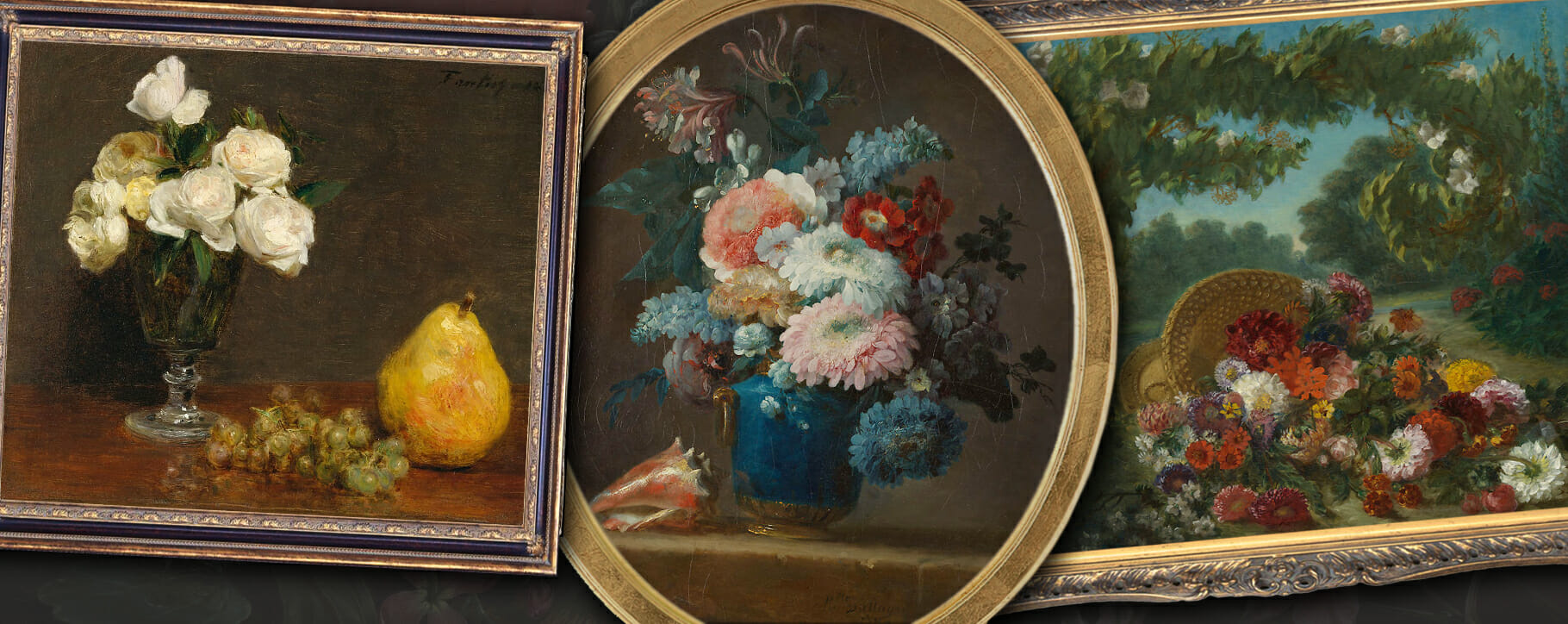 Above: examples of still life painting by Henri Fantin-Latour, Anne Vallayer-Coster, and Eugène Delacroix
Above: examples of still life painting by Henri Fantin-Latour, Anne Vallayer-Coster, and Eugène Delacroix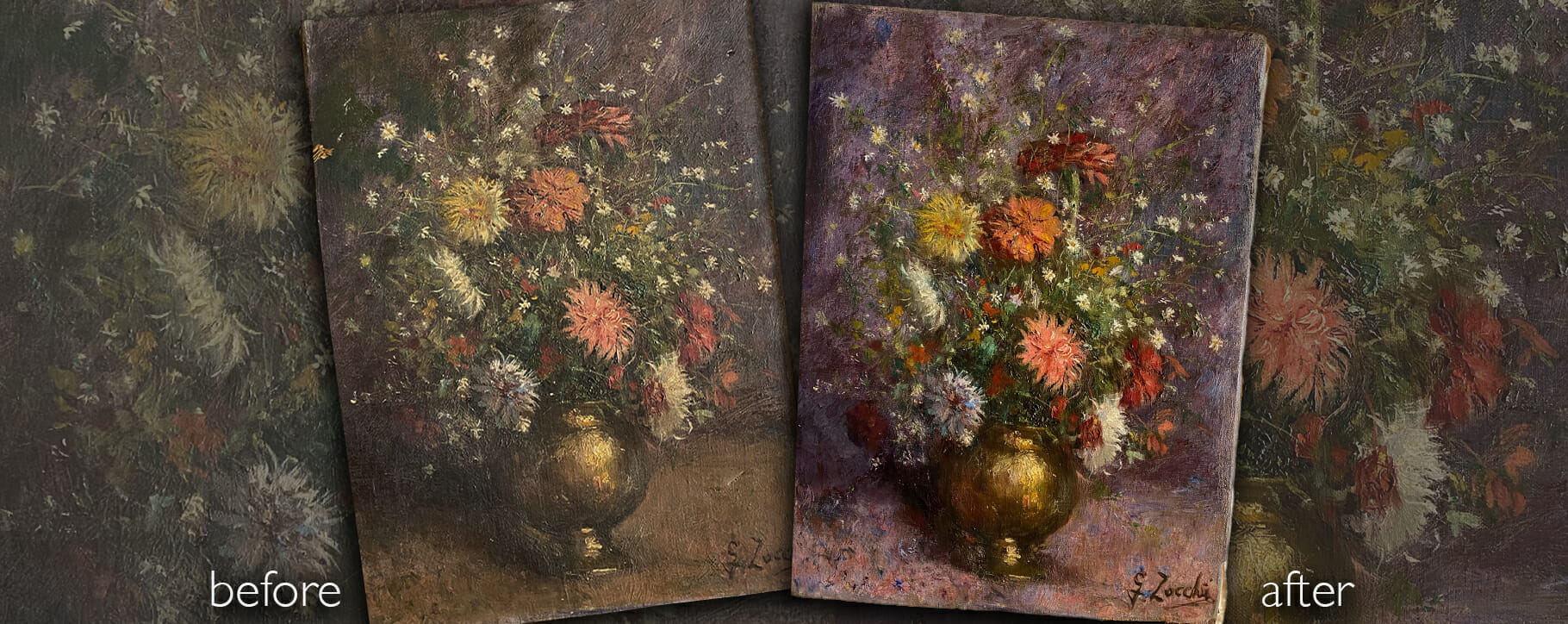 Above: a still life painting of flowers, before and after restoration in our studio – a bright purple background was revealed
Above: a still life painting of flowers, before and after restoration in our studio – a bright purple background was revealed Above: two wall paintings from Pompeii displaying still life with trompe-l’œil techniques and a 2nd century mosaic
Above: two wall paintings from Pompeii displaying still life with trompe-l’œil techniques and a 2nd century mosaic 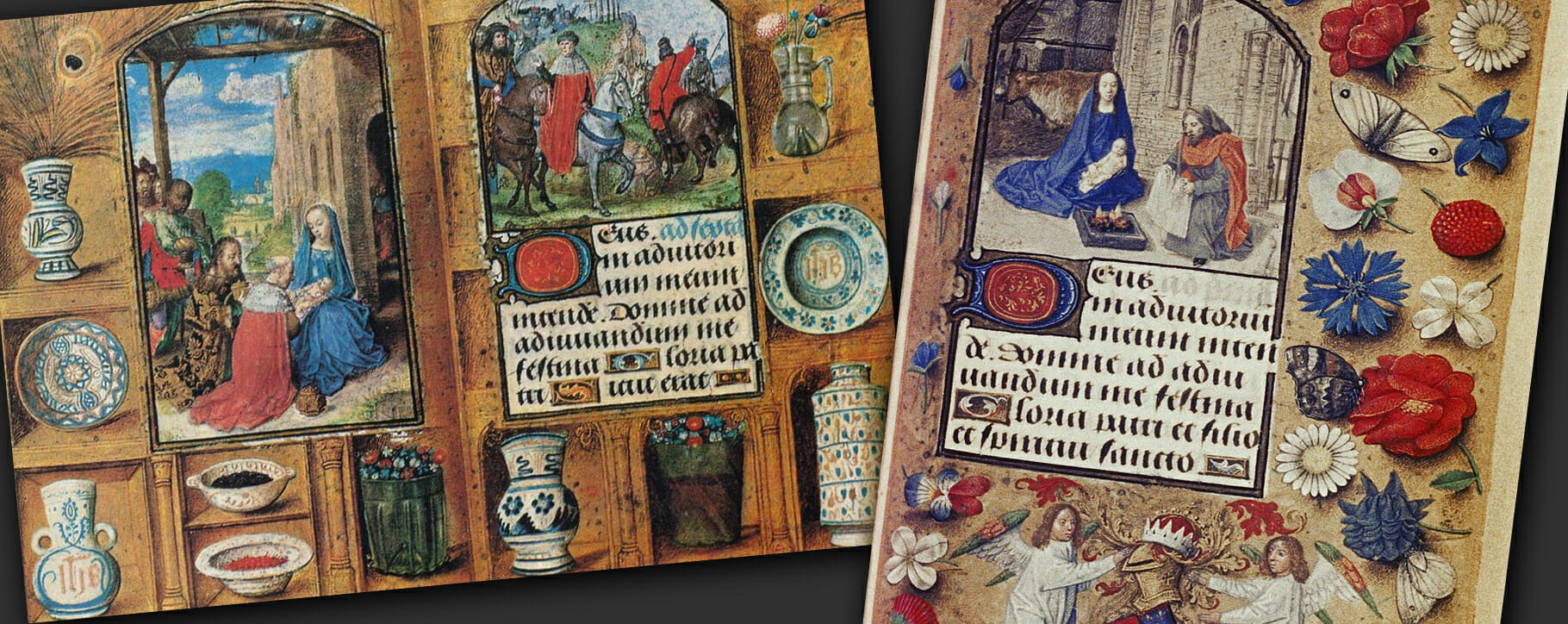 Above: examples of illuminated manuscript still life as seen in the Book of Hours from the 1470s
Above: examples of illuminated manuscript still life as seen in the Book of Hours from the 1470s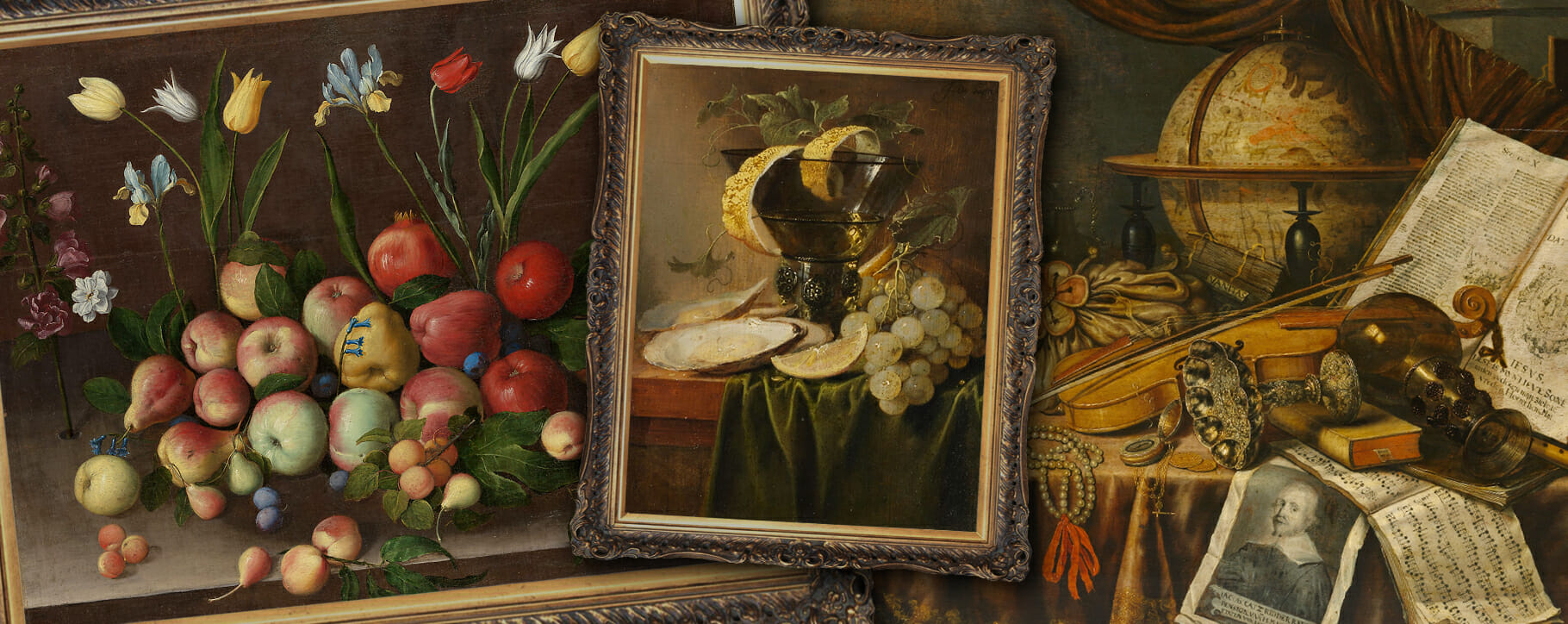 Above: Fruit and Flowers by Orsola Maddalena Caccia (1630), Still Life with a Glass and Oysters by Jan Davidsz de Heem (1640) and Vanitas Still Life by Edwaert Collier (1662)
Above: Fruit and Flowers by Orsola Maddalena Caccia (1630), Still Life with a Glass and Oysters by Jan Davidsz de Heem (1640) and Vanitas Still Life by Edwaert Collier (1662) Above: a selection of vanitas paintings including Allegory of Charles I of England and Henrietta of France by Carstian Luyckx (1670), Trompe l’oeil with Studio Wall by Cornelis Norbertus Gijsbrechts (1668) and Vanitas with Skull by Cornelis Van Der Meulen (1688)
Above: a selection of vanitas paintings including Allegory of Charles I of England and Henrietta of France by Carstian Luyckx (1670), Trompe l’oeil with Studio Wall by Cornelis Norbertus Gijsbrechts (1668) and Vanitas with Skull by Cornelis Van Der Meulen (1688)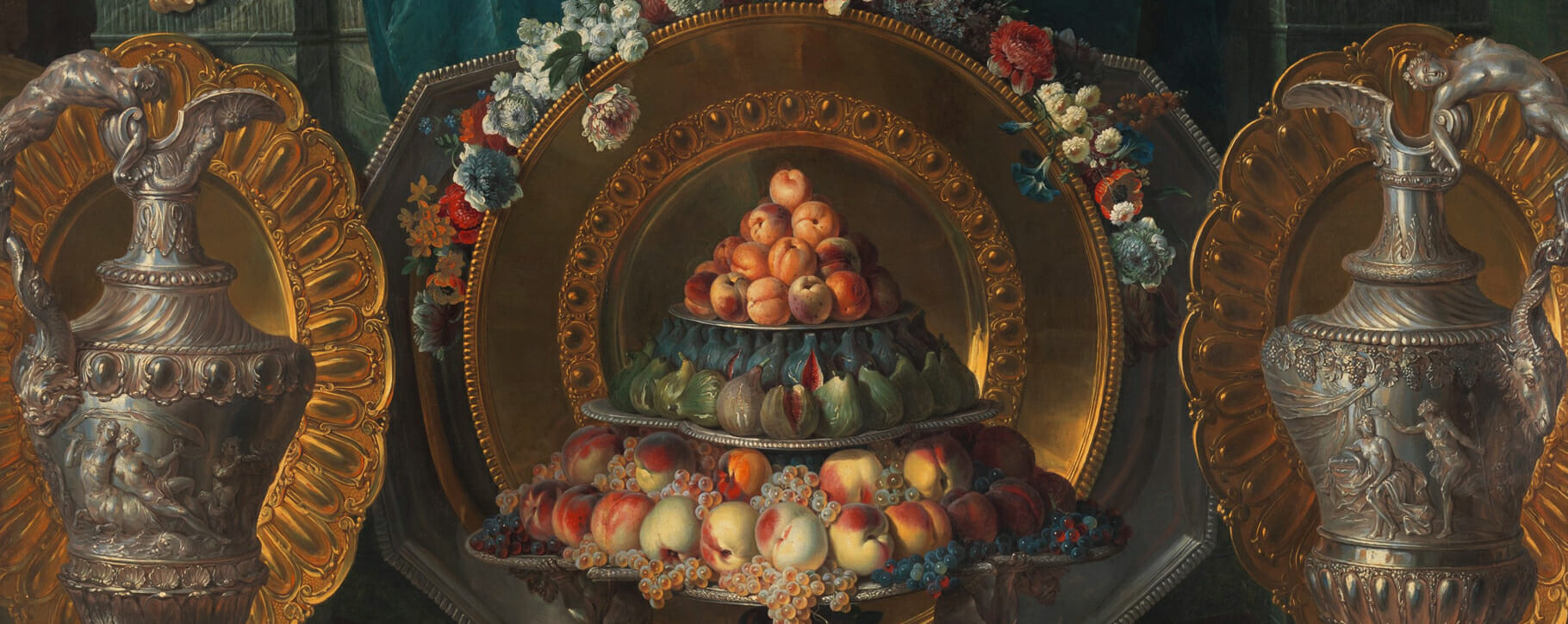 Above: a detail from Still Life with Silver by Alexandre François Desportes, 1720
Above: a detail from Still Life with Silver by Alexandre François Desportes, 1720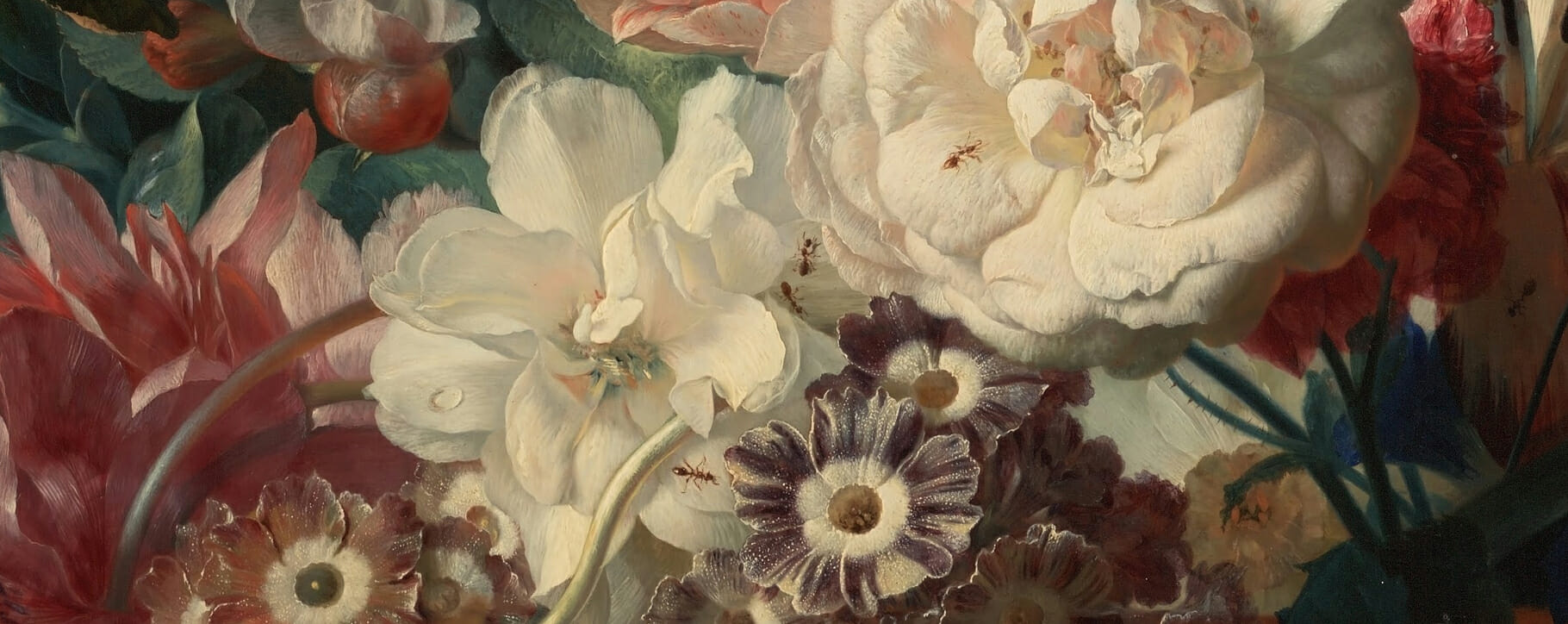 Above: a detail from a painting by Jan van Huysum showing the lifelike ants crawling across a vase of flowers
Above: a detail from a painting by Jan van Huysum showing the lifelike ants crawling across a vase of flowers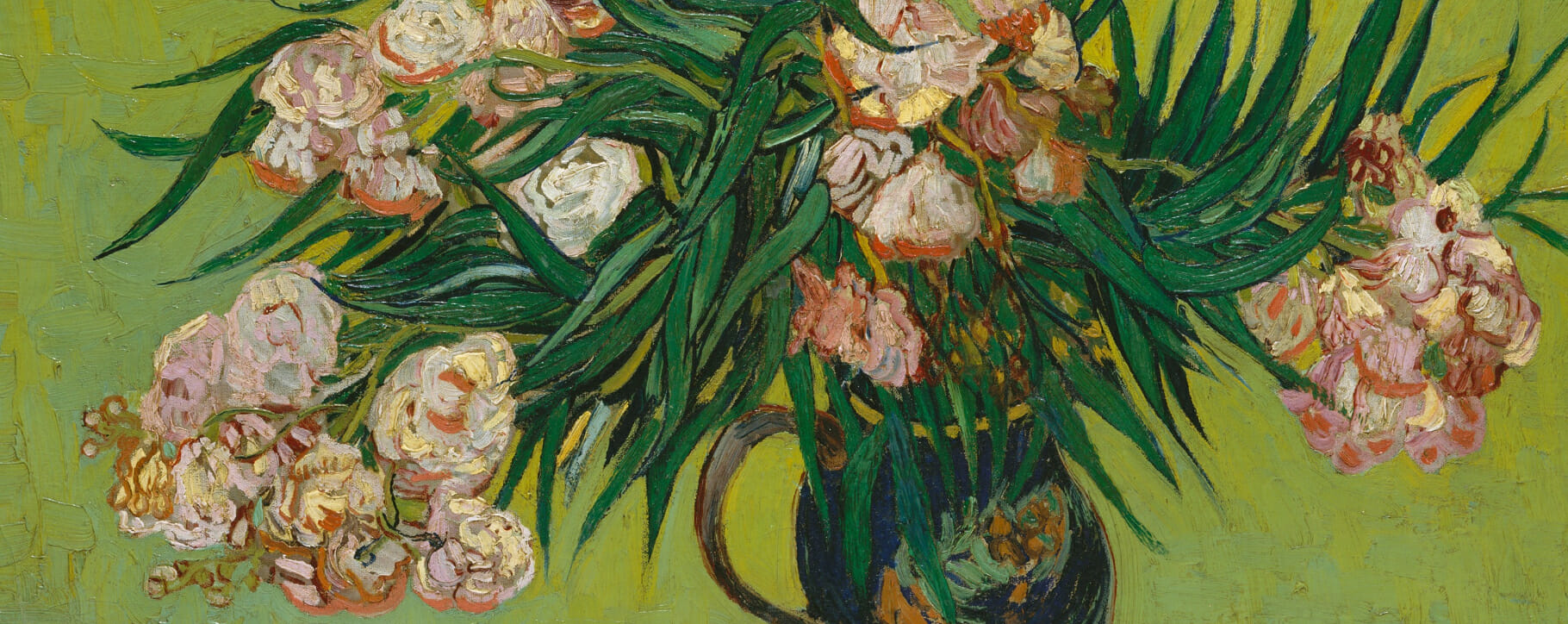 Above: a detail from Oleanders by Vincent Van Gogh dated to 1888
Above: a detail from Oleanders by Vincent Van Gogh dated to 1888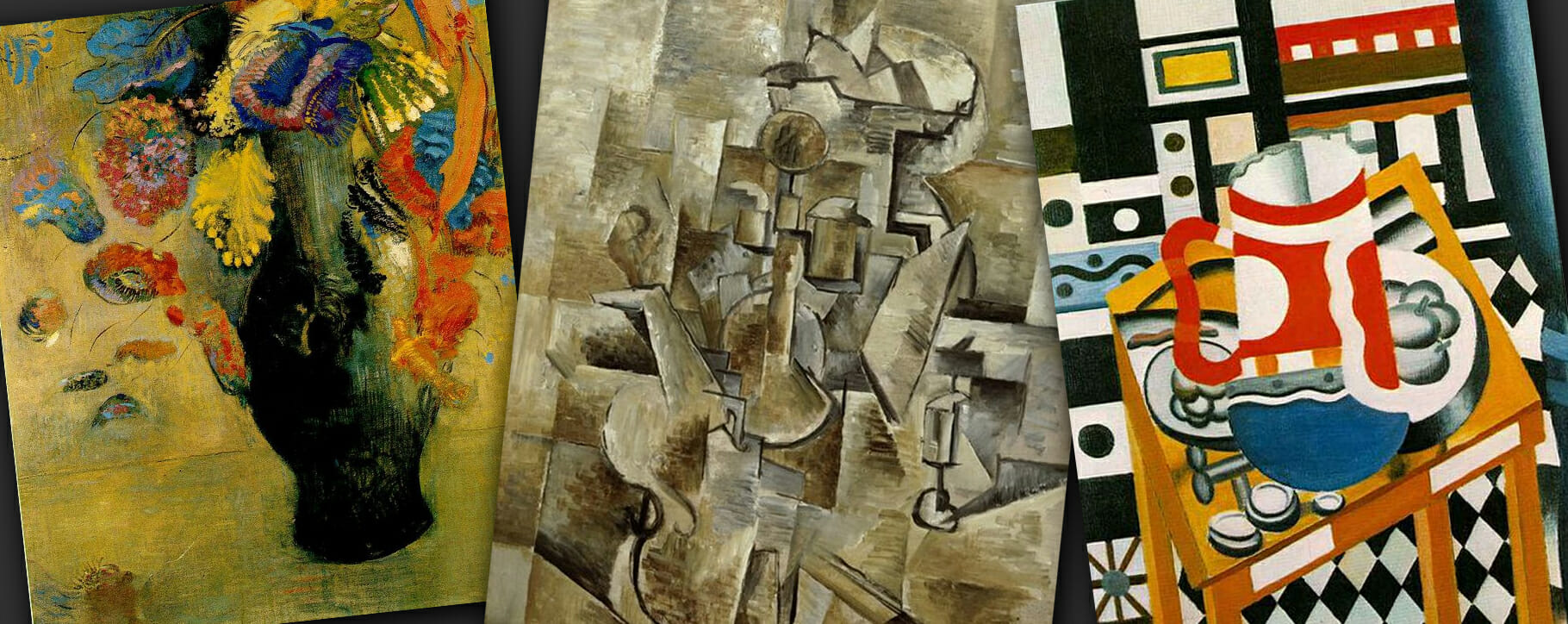 Above: 20th century still life examples including Flowers by Odilon Redon (1903), Violin and Candlestick by Georges Braque (1910) and Still Life with a Beer Mug by Fernand Léger (1921)
Above: 20th century still life examples including Flowers by Odilon Redon (1903), Violin and Candlestick by Georges Braque (1910) and Still Life with a Beer Mug by Fernand Léger (1921)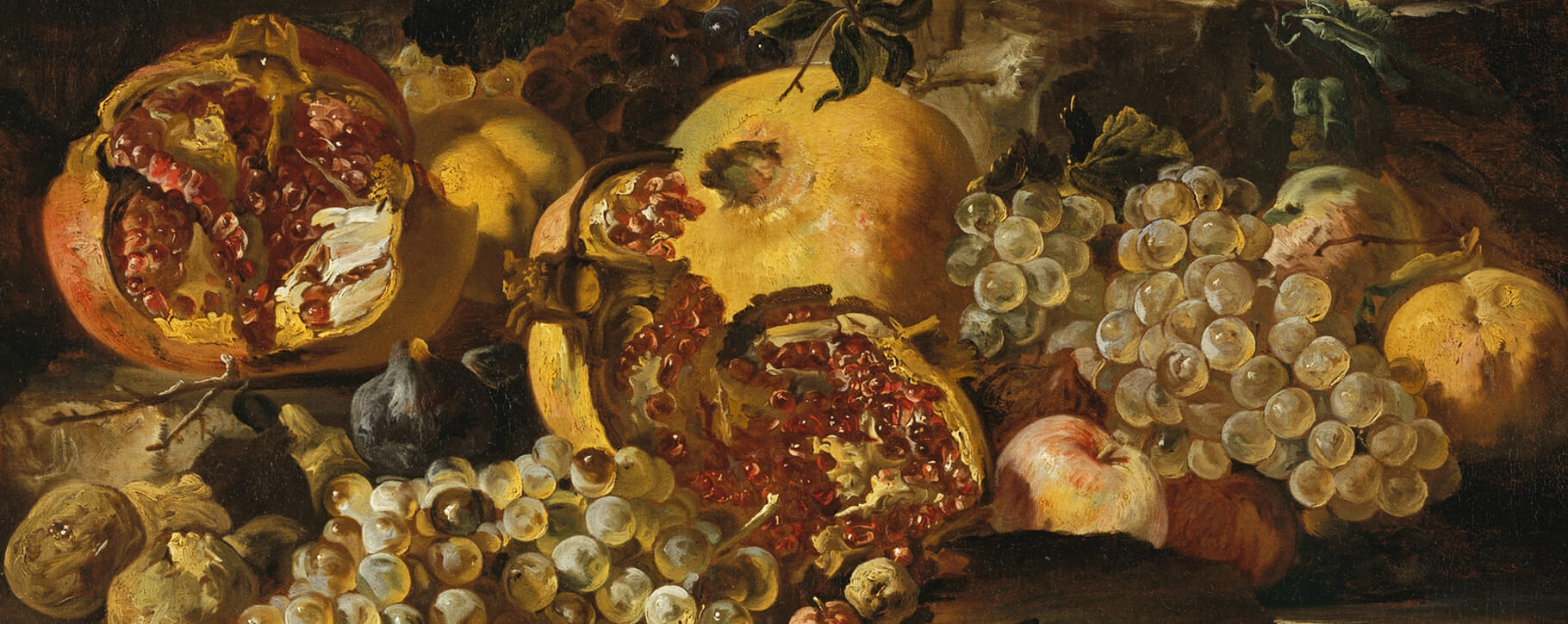 Above: this still life features fruits which are symbolic of classical decadence with the grapes relating to bacchus and the pomegranate to the myth of Persephone and the underworld
Above: this still life features fruits which are symbolic of classical decadence with the grapes relating to bacchus and the pomegranate to the myth of Persephone and the underworld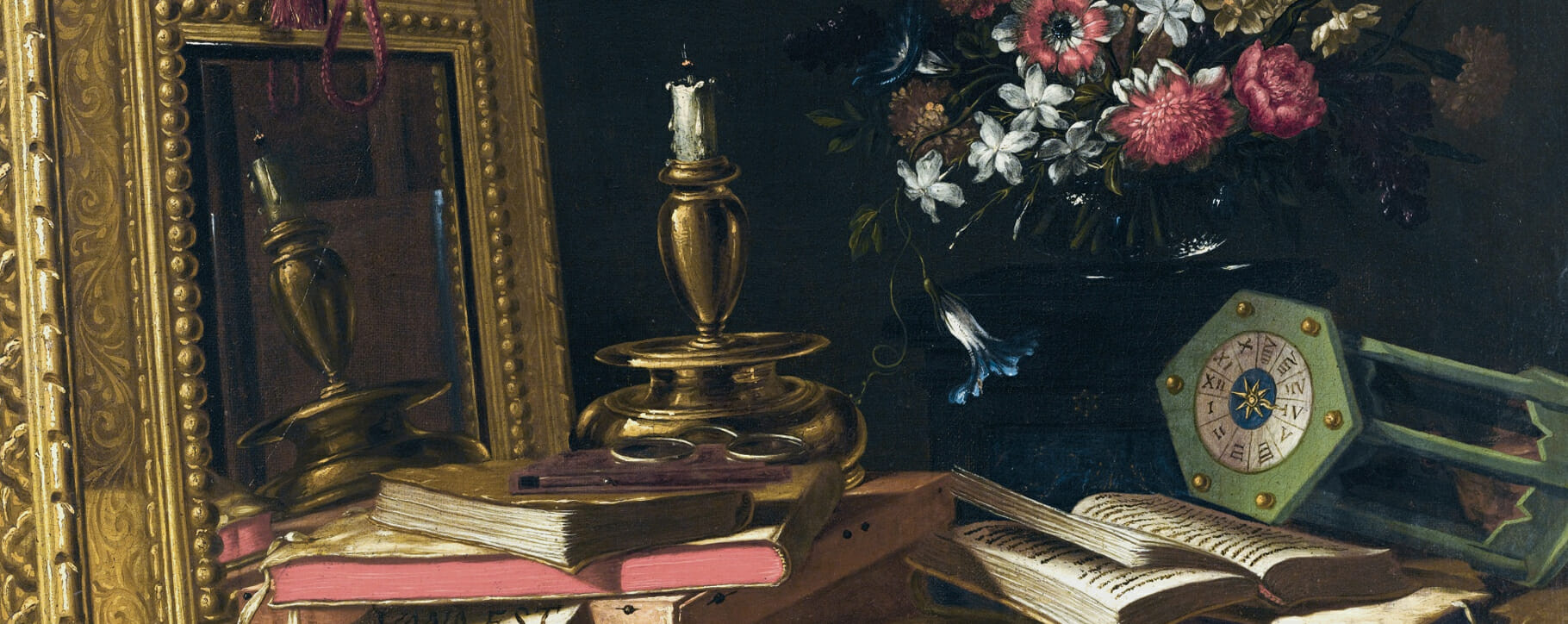 Above: a detail from a Vanitas with Mirror, Candle, Hourglass, Books, & Flowers in a Vase on Draped Table, unknown artist dated to 1650
Above: a detail from a Vanitas with Mirror, Candle, Hourglass, Books, & Flowers in a Vase on Draped Table, unknown artist dated to 1650 Above: a detail from a Victorian still life of flowers and a birds nest by Severin Roesen dated to 1850-55
Above: a detail from a Victorian still life of flowers and a birds nest by Severin Roesen dated to 1850-55 Above: a detail from Still Life with a Skull and a Writing Quill by Pieter Claesz (1628)
Above: a detail from Still Life with a Skull and a Writing Quill by Pieter Claesz (1628)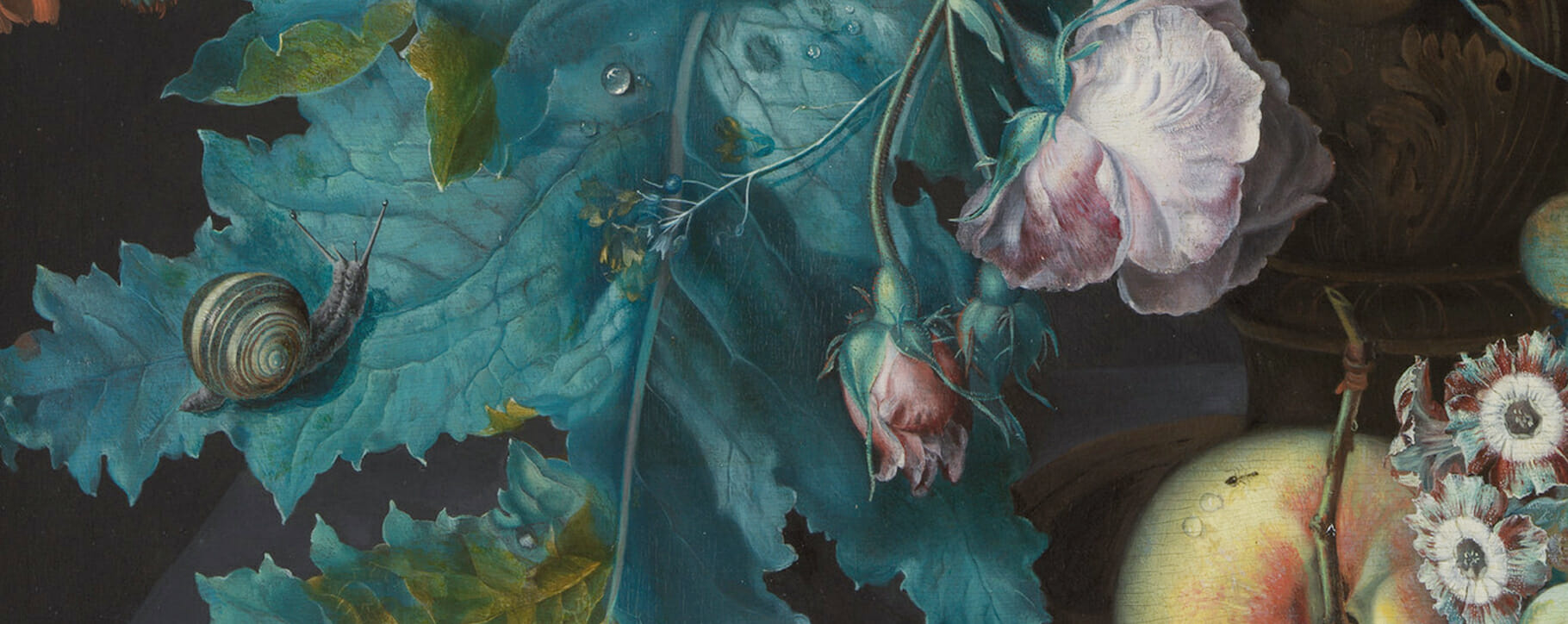 Above: a snail and ant featured in a vase of flowers by Margareta Haverman (1716)
Above: a snail and ant featured in a vase of flowers by Margareta Haverman (1716)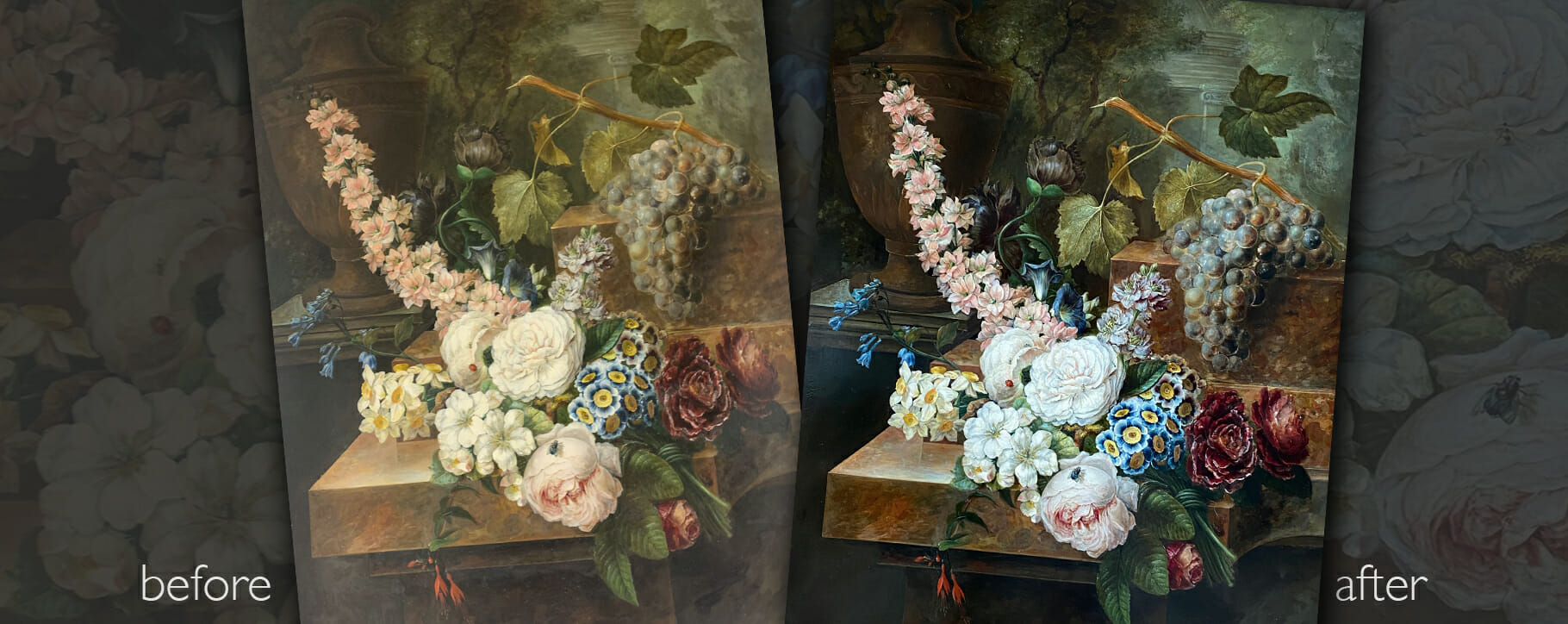 Above: an 18th century floral still life restored by our conservators by removing the discoloured varnish and surface contamination
Above: an 18th century floral still life restored by our conservators by removing the discoloured varnish and surface contamination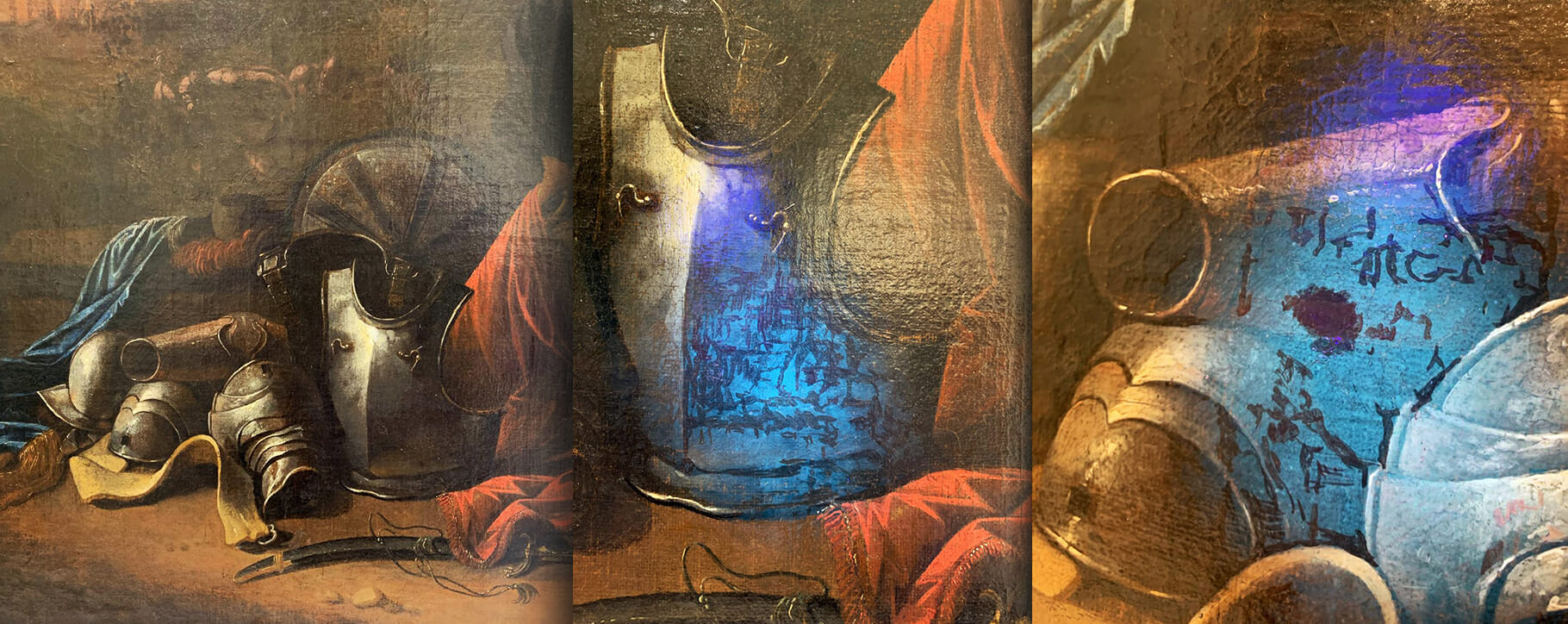 Above: an example of the hidden overpainting found on historic artworks, this is sometimes not seen by the naked eye and requires a conservator to view
Above: an example of the hidden overpainting found on historic artworks, this is sometimes not seen by the naked eye and requires a conservator to view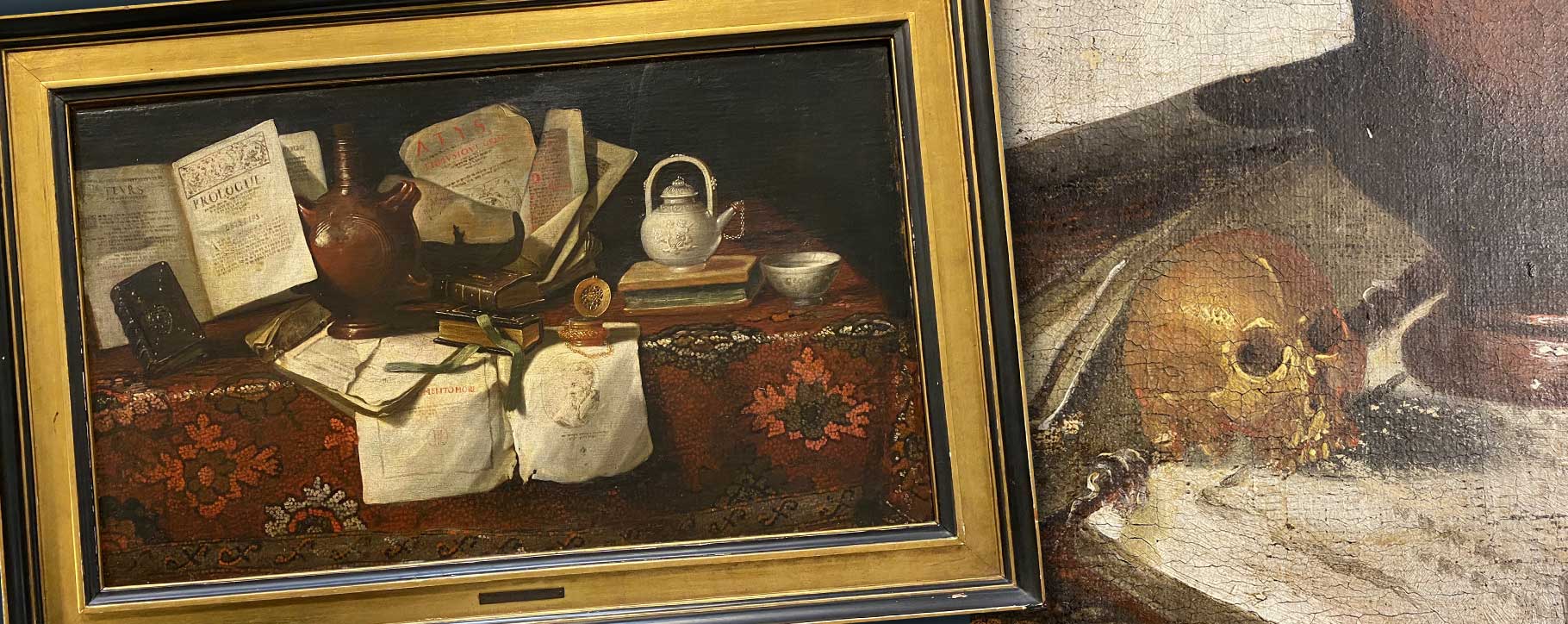 Above: the painting before restoration and the skull detail which was found to the left of the brown jug by our conservators
Above: the painting before restoration and the skull detail which was found to the left of the brown jug by our conservators Above: before and after the restoration of a modern sunflower painting in our studio
Above: before and after the restoration of a modern sunflower painting in our studio




